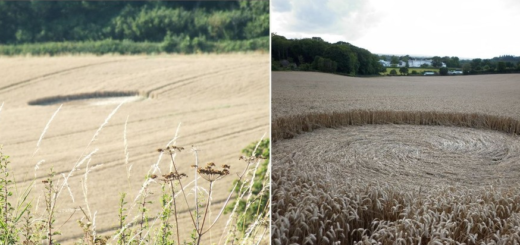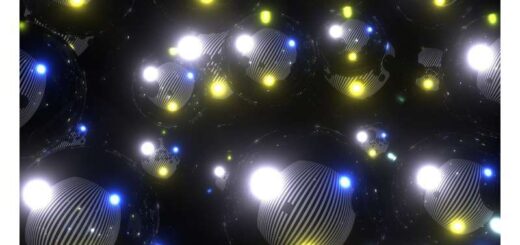Roswell Aliens Not So Alien

Nearly 70 years after extraterrestrials supposedly pushed the wrong button in their spacecraft and nose-dived into scrubby ranchland near Roswell, New Mexico, that town is again in the news.
This time the headlines are centered on the discovery of an old Kodachrome slide showing a small, atrophied body laid out in a display case. It seems that the slide was found two dozen years ago in the house of a deceased Arizona couple, although its true provenance is sketchy. Recently, a handful of UFO researchers has decided that this old photo actually depicts an alien corpse, and possibly a victim of the 1947 crash that put Roswell on the public’s mental map.
That would be important, if true.
And the researchers claimed it was true. They scheduled a large public event in Mexico City on May 5 to debut the slide, calling it the “smoking gun” that would finally prove that aliens are visiting Earth. Six thousand people were intrigued enough to fork over $200 each to attend.
But you should be glad that you weren’t among them. Just one look at this lugubrious photo should trip your baloney detector. The body looks human.
Mind you, the fleshy parts are pretty mummified, but the skeleton is familiar, with a skull on top, an extensive rib cage comprising the upper body, four articulated appendages that look like arms and legs, and … Well, it could be a shrunken and shriveled version of your cousin Vinny.
So why’s that so suspicious? After all, nine out of ten movie aliens are vaguely humanoid.
Yes, and six out of ten movie aliens are also blessed with gallons of mucous. You might infer that’s because most habitable planets are really dry. You might more realistically infer that snotty aliens are merely a cinematic convention.
The Hollywood depiction of aliens is a narrative shortcut. When diminutive, smooth-skinned, big-eyed creatures make their appearance on-screen — well, you don’t need a lot of back story to explain these guys to the audience. Everyone knows where they call home.
But how likely is it that any real aliens will resemble us as closely as the emblematic grays? Not very.
Consider the fact that hominid, human-like creatures have only populated our planet for 4 million years, or less than one percent of the time that multicellular creatures have existed here. Our body plan is hardly representative. Trilobites, on the other hand, were a successful terrestrial life form for hundreds of millions of years. But you don’t see many cinema aliens that look like trilobites. Or like stegosauri, for that matter.
We have an anthropocentric bias when we think of beings beyond Earth.
Now you might argue, as some evolutionary biologists have, that the human body plan is somehow ideal for a thinking animal, and a process called convergent evolution will ensure that Ferengi and Na’vi vaguely resemble you. Convergent evolution accounts for the streamlined appearance of such diverse animal lineages as dolphins (mammals) and barracudas (fish). Using this logic, we might be tempted to conclude that many aliens will look humanoid.
But would an alien’s skeletal structure be so remarkably similar to our own? When you look at the stacked-up bones in your local natural history museum, their arrangements all look pretty similar, from whales to weasels. But that’s less convergent evolution than inheritance. This type of skeletal scaffolding was established about 400 million years ago with the first tetrapods — vaguely fish-like creatures that had four fins (ancestors of our arms and legs). It could easily have been otherwise, and chances are that for E.T. it was. Its body plan would reflect the evolutionary history of its planet, not ours.
I would have been more likely to think there was something to the Roswell Kodachrome if the skeleton had half as many ribs as I do, and two additional arms.
Our anthropocentric viewpoint extends beyond the mere appearance of aliens. We figure their priorities will also be similar. I have a folder full of letters from people who confidently explain that the reason we have yet to find evidence for extraterrestrial intelligence is that any advanced society would be repelled by our bad behavior — our predilection for war, our enthusiasm for wrecking the environment. The aliens refuse to get in touch on moral grounds.
The idea that beings who are thousands or millions of years more advanced than us would be put off by our depressing deportment makes about as much sense as saying that anthropologists should decline to study the Aztecs because of the latter’s brutal rituals. Don’t assume that your problems will define their interests. But back to the Roswell slide. Only days after the hoopla in Mexico City, several determined folk using imaging enhancing software were able to decipher a small card in the photo, placed next to the supposed alien corpse. It read “mummified body of two year old boy.” Turns out, the display had been an artifact in the Million Dollar Museum in White’s City, New Mexico. This E.T. came from Earth.
All of this should underscore the need for skepticism the next time someone offers you purported alien imagery that looks vaguely like your cousin.
In fact, given the inevitable trajectory of technology, it’s likely that any real, visiting extraterrestrial visitors would be some sort of artificial intelligence. The advantage for them is that, being endlessly reparable, they can undertake interstellar journeys that might take many millennia. The advantage for you is that they’ll have no interest in boiling you for dinner.
And if they end up in a museum display case, you can be sure they won’t have ribs.



 Creators of mankind
Creators of mankind Description of “Tall white aliens”
Description of “Tall white aliens” Where they came from?
Where they came from? About hostile civilizations
About hostile civilizations The war for the Earth
The war for the Earth “Tall white aliens” about eternal life
“Tall white aliens” about eternal life Video: “Nordic aliens”
Video: “Nordic aliens” Aliens
Aliens Alien encounters
Alien encounters The aliens base
The aliens base UFO
UFO Technology UFO
Technology UFO Underground civilization
Underground civilization Ancient alien artifacts
Ancient alien artifacts Military and UFO
Military and UFO Mysteries and hypotheses
Mysteries and hypotheses Scientific facts
Scientific facts


















